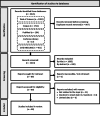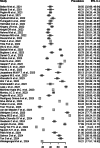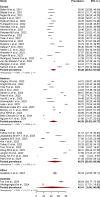Post-COVID syndrome prevalence: a systematic review and meta-analysis
- PMID: 38965510
- PMCID: PMC11223303
- DOI: 10.1186/s12889-024-19264-5
Post-COVID syndrome prevalence: a systematic review and meta-analysis
Abstract
Background: Since the Coronavirus disease 2019 (COVID-19) pandemic began, the number of individuals recovering from COVID-19 infection have increased. Post-COVID Syndrome, or PCS, which is defined as signs and symptoms that develop during or after infection in line with COVID-19, continue beyond 12 weeks, and are not explained by an alternative diagnosis, has also gained attention. We systematically reviewed and determined the pooled prevalence estimate of PCS worldwide based on published literature.
Methods: Relevant articles from the Web of Science, Scopus, PubMed, Cochrane Library, and Ovid MEDLINE databases were screened using a Preferred Reporting Items for Systematic Reviews and Meta-Analyses-guided systematic search process. The included studies were in English, published from January 2020 to April 2024, had overall PCS prevalence as one of the outcomes studied, involved a human population with confirmed COVID-19 diagnosis and undergone assessment at 12 weeks post-COVID infection or beyond. As the primary outcome measured, the pooled prevalence of PCS was estimated from a meta-analysis of the PCS prevalence data extracted from individual studies, which was conducted via the random-effects model. This study has been registered on PROSPERO (CRD42023435280).
Results: Forty eight studies met the eligibility criteria and were included in this review. 16 were accepted for meta-analysis to estimate the pooled prevalence for PCS worldwide, which was 41.79% (95% confidence interval [CI] 39.70-43.88%, I2 = 51%, p = 0.03). Based on different assessment or follow-up timepoints after acute COVID-19 infection, PCS prevalence estimated at ≥ 3rd, ≥ 6th, and ≥ 12th months timepoints were each 45.06% (95% CI: 41.25-48.87%), 41.30% (95% CI: 34.37-48.24%), and 41.32% (95% CI: 39.27-43.37%), respectively. Sex-stratified PCS prevalence was estimated at 47.23% (95% CI: 44.03-50.42%) in male and 52.77% (95% CI: 49.58-55.97%) in female. Based on continental regions, pooled PCS prevalence was estimated at 46.28% (95% CI: 39.53%-53.03%) in Europe, 46.29% (95% CI: 35.82%-56.77%) in America, 49.79% (95% CI: 30.05%-69.54%) in Asia, and 42.41% (95% CI: 0.00%-90.06%) in Australia.
Conclusion: The prevalence estimates in this meta-analysis could be used in further comprehensive studies on PCS, which might enable the development of better PCS management plans to reduce the effect of PCS on population health and the related economic burden.
Keywords: COVID-19; Long COVID; Post-COVID syndrome; Prevalence.
© 2024. The Author(s).
Conflict of interest statement
The authors declare no competing interests.
Figures







Similar articles
-
Global Prevalence of Long COVID, its Subtypes and Risk factors: An Updated Systematic Review and Meta-Analysis.medRxiv [Preprint]. 2025 Jan 6:2025.01.01.24319384. doi: 10.1101/2025.01.01.24319384. medRxiv. 2025. PMID: 39830235 Free PMC article. Preprint.
-
Pulmonary function and chest computed tomography abnormalities 6-12 months after recovery from COVID-19: a systematic review and meta-analysis.Respir Res. 2022 Sep 6;23(1):233. doi: 10.1186/s12931-022-02163-x. Respir Res. 2022. PMID: 36068582 Free PMC article.
-
Mid and long-term neurological and neuropsychiatric manifestations of post-COVID-19 syndrome: A meta-analysis.J Neurol Sci. 2022 Mar 15;434:120162. doi: 10.1016/j.jns.2022.120162. Epub 2022 Jan 29. J Neurol Sci. 2022. PMID: 35121209 Free PMC article. Review.
-
Beyond the black stump: rapid reviews of health research issues affecting regional, rural and remote Australia.Med J Aust. 2020 Dec;213 Suppl 11:S3-S32.e1. doi: 10.5694/mja2.50881. Med J Aust. 2020. PMID: 33314144
-
Bias due to selective inclusion and reporting of outcomes and analyses in systematic reviews of randomised trials of healthcare interventions.Cochrane Database Syst Rev. 2014 Oct 1;2014(10):MR000035. doi: 10.1002/14651858.MR000035.pub2. Cochrane Database Syst Rev. 2014. PMID: 25271098 Free PMC article.
Cited by
-
Quality of Sleep and Mental Symptoms Contribute to Health-Related Quality of Life after COVID-19 Pneumonia, a Follow-Up Study of More than 2 Years.Biomedicines. 2024 Jul 16;12(7):1574. doi: 10.3390/biomedicines12071574. Biomedicines. 2024. PMID: 39062147 Free PMC article.
-
Childhood trauma and mental health outcomes in Post-COVID Syndrome: Results from a cross-sectional study in Germany.Brain Behav Immun Health. 2025 Jul 21;48:101069. doi: 10.1016/j.bbih.2025.101069. eCollection 2025 Oct. Brain Behav Immun Health. 2025. PMID: 40756579 Free PMC article.
-
Reply to correspondence on "Long-term gastrointestinal and hepatobiliary outcomes of COVID-19: A multinational population-based cohort study from South Korea, Japan, and the UK".Clin Mol Hepatol. 2025 Jan;31(1):e123-e124. doi: 10.3350/cmh.2024.0966. Epub 2024 Nov 6. Clin Mol Hepatol. 2025. PMID: 39501573 Free PMC article. No abstract available.
-
Post COVID-19 among young adults- prevalence and associations with general health, stress, and lifestyle factors.BMC Public Health. 2025 Apr 9;25(1):1330. doi: 10.1186/s12889-025-22522-9. BMC Public Health. 2025. PMID: 40205367 Free PMC article.
-
Psychosocial and pandemic-related circumstances of suicide deaths in 2020: Evidence from the National Violent Death Reporting System.PLoS One. 2024 Oct 11;19(10):e0312027. doi: 10.1371/journal.pone.0312027. eCollection 2024. PLoS One. 2024. PMID: 39392837 Free PMC article.
References
-
- World Health Organization . WHO Director-General’s Opening Remarks at the Media Briefing on COVID-19 - 11 March 2020. 2020.
-
- Ministry of Health Malaysia . Post Covid-19 Management Protocol. 2021.
Publication types
MeSH terms
LinkOut - more resources
Full Text Sources
Medical
Research Materials
Miscellaneous

